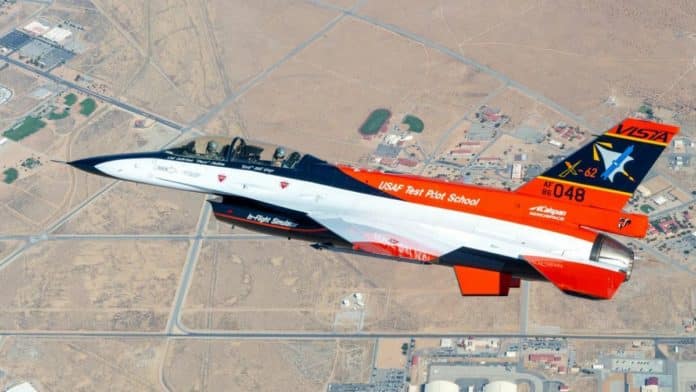Lockheed Martin on Tuesday announced that it has successfully flown “a one-of-a-kind training aircraft” by an artificial intelligence (AI) agent for more than 17 hours. This is the first time that an AI has been used to fly a tactical aircraft.
The training aircraft, VISTA (Variable In-flight Simulation Test Aircraft) is developed by Lockheed Martin Skunk Works in collaboration with Calspan Corporation for the U.S. Air Force Test Pilot School (USAF TPS).
VISTA took to the air for over 17 hours during a series of tests that took place in December 2022 at the Edwards Air Force Base in California.
VISTA X-62A is a “modified F-16D Block 30 Peace Marble Il aircraft upgraded with Block 40 avionics”. Originally designated as NF-16D, it was declared a national asset by the U.S. Air Force and formally renamed to VISTA X-62A in June 2021.
Built on open systems architecture, VISTA is equipped with software that allows it to impersonate the performance features of other piloted fighter jets. It is also able to operate autonomously.
“VISTA will allow us to parallelize the development and test of cutting-edge artificial intelligence techniques with new uncrewed vehicle designs,” said Dr. M. Christopher Cotting, the Director of Research at the USAF TPS on Monday in a press release.
“This approach, combined with focused testing on new vehicle systems as they are produced, will rapidly mature autonomy for uncrewed platforms and allow us to deliver tactically relevant capability to our warfighter.”
Although the AI was piloting the fighter jet, there was also a safety pilot on board to take back control of the aircraft if anything went wrong.
The aircraft was recently upgraded to include an updated VISTA Simulation System (VSS), Lockheed Martin’s Model Following Algorithm (MFA), and System for Autonomous Control of the Simulation (SACS).
The integration of SACS and MFA systems provides new capabilities to the VISTA, which allows it to conduct the “most advanced flight test experiments” making it the flying testbed for autonomy and AI.
Further, the SACS system features the Skunk Works Enterprise-wide Open Systems Architecture (E-OSA), which powers the Enterprise Mission Computer version 2 (EMC2) or “Einstein Box.” The EMC2 is designed to allow older systems to link together for sharing of data across all domains.
Additionally, the aircraft also has advanced sensors, a Multi-Level Security solution, and a set of Getac tablet displays in both cockpits.
“These components enhance VISTA’s capabilities while maintaining its rapid-prototyping advantage, specifically allowing for quick software changes to increase the frequency of flight test flights and accelerating the pace of AI and autonomy development to meet urgent national security needs,” says Lockheed.
It’s hoped that VISTA will continue to play an integral role in the rapid development of AI and autonomy capabilities for the U.S. Air Force.
Currently, the VISTA is undergoing a series of routine inspections, and tests will continue at Edwards Air Force Base throughout 2023, after which it will resume flying.

